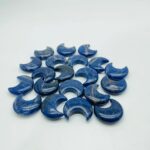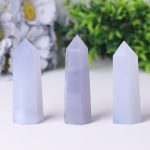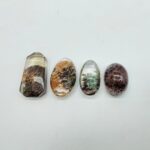Ultraviolet (UV) reactive crystals are fascinating materials that absorb UV light and emit a visible glow. This unique property makes them ideal for a wide range of applications, from decorative lighting to scientific research. Here is a comprehensive list of UV reactive crystals, along with their properties and uses:

Fluorescence
Fluorescence is the emission of visible light by a substance that has absorbed electromagnetic radiation, such as UV light. The phenomenon is commonly observed in UV reactive crystals, which absorb UV light and then re-emit it as visible light of a different color. The color of the emitted light depends on the specific crystal structure and the impurities present.
The fluorescence of UV reactive crystals is typically long-lasting, with the emitted light continuing for several minutes or even hours after the UV light is removed. This persistence makes them ideal for use in glow-in-the-dark applications, such as nightlights and emergency lighting.
Phosphorescence
Phosphorescence is similar to fluorescence, but the emitted light continues for a longer period after the UV light is removed. Phosphorescent materials store the absorbed energy and release it slowly over time. This property makes them useful for applications where long-lasting illumination is desired, such as in watch dials and instrument panels.
The duration of phosphorescence varies depending on the material, with some crystals emitting light for several hours or even days after exposure to UV light.
Applications of UV Reactive Crystals
UV reactive crystals have a wide range of applications, both decorative and functional. Some of the most common uses include:
- Decorative lighting: UV reactive crystals can be used to create stunning lighting effects, both indoors and outdoors. They are often used in nightlights, mood lighting, and accent lighting.
- Scientific research: UV reactive crystals are used in a variety of scientific research applications, including spectroscopy, microscopy, and laser technology. They can be used to study the properties of materials, identify chemical compounds, and develop new medical treatments.
- Industrial applications: UV reactive crystals are used in a variety of industrial applications, including quality control, security, and manufacturing. They can be used to detect flaws in materials, identify counterfeit products, and track the movement of goods.
List of UV Reactive Crystals
Here’s a list of UV reactive crystals including the color of its fluorescence:
| Crystal | Color of Fluorescence |
|---|---|
| Calcite | Orange |
| Fluorite | Blue, Green, or Purple |
| Ruby | Red |
| Sapphire | Blue |
| Diamond | Blue |
| Emerald | Green |
| Topaz | Yellow |
| Amethyst | Violet |
Properties of UV Reactive Crystals
The properties of UV reactive crystals vary depending on the specific material. However, some general properties include:
-
Hardness: UV reactive crystals are typically hard and durable, with a Mohs hardness of 7 or higher. This makes them resistant to scratching and wear.
-
Density: UV reactive crystals are typically dense, with a density of 3 grams per cubic centimeter or higher. This makes them heavy for their size.
-
Refractive index: UV reactive crystals have a high refractive index, which means that they bend light more than other materials. This property gives them a sparkly appearance.
-
Cleavage: UV reactive crystals typically have a good cleavage, which means that they can be easily split along certain planes. This property can be used to create desired shapes and sizes for various applications.
Uses of UV Reactive Crystals
UV reactive crystals have various uses, such as:
-
Jewelry: UV reactive crystals are often used in jewelry, such as rings, necklaces, and earrings. They are particularly popular in glow-in-the-dark jewelry.
-
Home decor: UV reactive crystals can be used in home decor, such as lamps, vases, and sculptures. They can create a unique and eye-catching addition to any room.
-
Artwork: UV reactive crystals can be used in artwork, such as paintings, sculptures, and mosaics. They can add a touch of luminescence and intrigue to any piece of art.
-
Science and research: UV reactive crystals are used in science and research, such as in spectroscopy and laser technology. They can help scientists study the properties of materials and develop new technologies.
-
Industrial and commercial applications: UV reactive crystals are used in industrial and commercial applications, such as in quality control and security. They can help manufacturers detect flaws in products and security personnel identify counterfeit items.
Common Mistakes to Avoid When Using UV Reactive Crystals
There are several common mistakes to avoid when using UV reactive crystals. These include:
-
Exposing the crystals to excessive heat: UV reactive crystals can be damaged by excessive heat. Avoid exposing them to temperatures above 100 degrees Celsius (212 degrees Fahrenheit).
-
Exposing the crystals to harsh chemicals: UV reactive crystals can be damaged by harsh chemicals, such as acids and bases. Avoid exposing them to these chemicals.
-
Storing the crystals in direct sunlight: UV reactive crystals can fade over time if they are stored in direct sunlight. Store them in a dark, cool place when not in use.
By following these tips, you can avoid damaging your UV reactive crystals and enjoy them for years to come.
Conclusion
UV reactive crystals are a fascinating and versatile material with a wide range of applications. Their unique ability to absorb UV light and emit visible light makes them ideal for use in decorative lighting, scientific research, and industrial applications. When used properly, UV reactive crystals can provide years of enjoyment and utility.




























